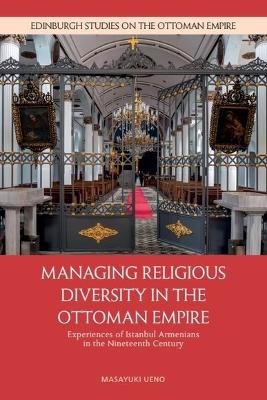
Managing Religious Diversity in the Ottoman Empire
Experiences of Istanbul Armenians in the Nineteenth Century
Seiten
2025
Edinburgh University Press (Verlag)
978-1-3995-4261-6 (ISBN)
Edinburgh University Press (Verlag)
978-1-3995-4261-6 (ISBN)
- Noch nicht erschienen (ca. April 2025)
- Versandkostenfrei
- Auch auf Rechnung
- Artikel merken
Provides a new account of the relationship between the Ottoman Empire and its non-Muslim subjects.
This book makes extensive use of Ottoman archival documents and Armenian sources to examine the changing arrangements between the Ottoman state and non-Muslim religious authorities from the seventeenth to the nineteenth centuries, focusing on Armenians, the second-largest non-Muslim community in the empire. Specifically, it discusses how the ruling circles of the empire reinforced their reliance on non-Muslim religious authorities at the turn of the eighteenth century, and attempted to limit the influence of non-Muslim clergymen and restrict the scope of non-Muslim communal activity from the mid-nineteenth century onwards. The book also highlights the responses of the Armenian lay and ecclesiastical elites in Istanbul, who did not sit back and watch as their rights and privileges were curtailed. Rather, they sought ways to protect and even expand their collective rights and find their place in the multireligious empire, both as individuals and as members of a religious community.
This book makes extensive use of Ottoman archival documents and Armenian sources to examine the changing arrangements between the Ottoman state and non-Muslim religious authorities from the seventeenth to the nineteenth centuries, focusing on Armenians, the second-largest non-Muslim community in the empire. Specifically, it discusses how the ruling circles of the empire reinforced their reliance on non-Muslim religious authorities at the turn of the eighteenth century, and attempted to limit the influence of non-Muslim clergymen and restrict the scope of non-Muslim communal activity from the mid-nineteenth century onwards. The book also highlights the responses of the Armenian lay and ecclesiastical elites in Istanbul, who did not sit back and watch as their rights and privileges were curtailed. Rather, they sought ways to protect and even expand their collective rights and find their place in the multireligious empire, both as individuals and as members of a religious community.
| Erscheint lt. Verlag | 30.4.2025 |
|---|---|
| Reihe/Serie | Edinburgh Studies on the Ottoman Empire |
| Zusatzinfo | Illustrations |
| Verlagsort | Edinburgh |
| Sprache | englisch |
| Maße | 156 x 234 mm |
| Themenwelt | Geschichte ► Allgemeine Geschichte ► Neuzeit (bis 1918) |
| Geisteswissenschaften ► Geschichte ► Regional- / Ländergeschichte | |
| Geschichte ► Teilgebiete der Geschichte ► Wirtschaftsgeschichte | |
| Geisteswissenschaften ► Religion / Theologie | |
| ISBN-10 | 1-3995-4261-3 / 1399542613 |
| ISBN-13 | 978-1-3995-4261-6 / 9781399542616 |
| Zustand | Neuware |
| Haben Sie eine Frage zum Produkt? |
Mehr entdecken
aus dem Bereich
aus dem Bereich
Europa 1848/49 und der Kampf für eine neue Welt
Buch | Hardcover (2023)
DVA (Verlag)
CHF 67,20
Giordano Bruno - ein ketzerisches Leben
Buch | Hardcover (2024)
C.H.Beck (Verlag)
CHF 41,85


